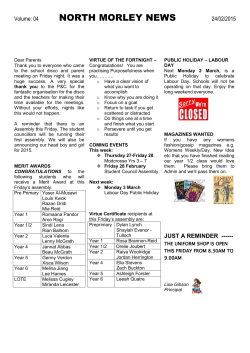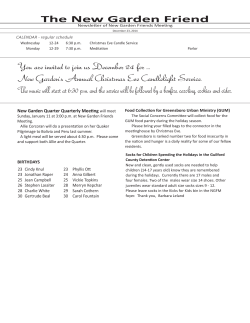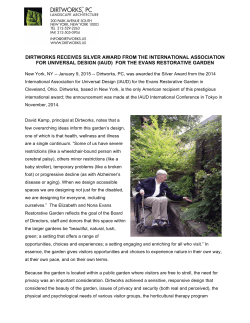
Regional Review - Central Atlantic Region
Inside this issue: Director’s Message Director’s Message 1 1 Regional Review 2 Symposium 2015 2 3 4 Ann Bucher 5 7 7 Bromeliads C.A.R. Conference Vol ume 4, Issu e 4 M arc h, 2015 DIRECTOR’S MESSAGE 7 8 What’s Happening in Stately News 12 Ohio?? At last, after the long winter, the gift of spring is just a few days away. Our gardens will soon brighten as they wake up and come to life. 9 13 10 What’s Happening in New Jersey?? 12 Stately News 13 The deadline for articles for the next issue of Regional Review is June 1, 2015. All copy is subject to cut/change. The Regional Review is not responsible for any copy submitted or printed. All material must be submitted to the Editor, Mary Ann FergusonRich at Mafr43@hotmail.com or mailed to 1166 Broadview Road, Tallmadge, OH 44278-3310 Regional Review is archived on the C.A.R. Website: www.ngccar.org. It is no surprise that over the past two years this region has rallied. Your clubs restored, refurbished, replanted and renewed the commitment to make a difference in and around your communities. Our common goal connected us. Your volunteer time and tireless efforts, in each community in which you served, made that community better. Your dedication is commendable and greatly valued. While we anticipate the arrival of spring with beautiful flowers and warmer temperatures, it is also time to remember that the 2015 CAR Conference, “A Floral Explosion”, hosted by the GCFP on October 27- 29, will take place at the Wyndham Gettysburg Conference Center in Gettysburg, PA. GCFP also sponsoring a Symposium immediately following the Conference at the Wyndham Gettysburg Conference Center. Information for both events are on the CAR web site: www.ngccar.org and just for the Symposium, on pages 2 and 3 of this newsletter. During the next couple of months, states will be installing the 2015-2017 officers who will lead our garden clubs for the next two years. It is very important that we support these new officers and governing boards and continue to work together to promote the invaluable work of garden club. During the 2015 NGC Convention in Louisville, Kentucky, Anne Bucher from the National Capital Area Inc., will be installed as the 2015-2017 CAR Director. Anne is an exceptionally capable, devoted member with a great deal of garden club experience. We are most fortunate to have her serve our Region in this capacity. Mary Ellen Alden will serve as CAR Alternate Director during Anne’s term. We welcome both Anne and Mary Ellen as we offer our encouragement and support for their administration. The last two years have been inspiring, educational, enlightening and heartwarming. It has been a privilege to work with the members of the Central Atlantic Region. Your encouragement, dedication, hard work and support is sincerely appreciated and I am very grateful. All copy is subject to cut/change. The Regional Review is not responsible for any copy or advertising submitted or printed. All material must be submitted to the Editor, Ruth Korn, at ruthkorn@verizon.net or 85 Fish Hawk Drive, Middletown, NJ 07748 1 Page 2 HOTEL INFORMATION SYMPOSIUM 2015 October 28-29, 2015 Wyndham Gettysburg 95 Presidential Circle Gettysburg, PA 17835 National Garden Clubs, Inc. Linda Nelson, President The Central Atlantic Region Mary Warshauer, Director Garden Club Federation of Pennsylvania Betsy Smith, President ****** Horticulture - Dottie Howatt ****** Symposium 2015 Chairman Diane B. Herman 1027 Willett Drive Johnstown, PA. 15905-1237 (814) 243-1064 dbherman10@atlanticbb.net Symposium 2015 Vice Chair Dorthy Yard 1117 Old Wattsburg Road Waterford, PA16441-4601 (814) 796-4131 dotyard@verizon.net Symposium 2015 Registrar Coordinating Credentials Chair Joyce Milberg “Simply Naked-Bare & Berried Branches” 635 Smokey Hill Road “The Dreaded Any Other Class” Tionesta, PA 16353-5247 Allied Topics – Arabella Dane (814) 755-7766 “It’s Magic” “Judging Photography “ thomsmil@pennswoods.net Design – Claudia Bates “Creating Rhythm with Line and Form” “ Armatures - You Can Do It!” 2 Reservations are to be made directly with Wyndham Gettysburg 95 Presidential Circle Gettysburg, Pennsylvania 17325 www.wyndhamgettysburg.com 1-717-339-0020 Rate is $119.00 per night + tax Request the NGC/CAR/SYMPOSIUM Block of rooms Reservation Deadline: September 27, 2015 Registration forms available GCFP Web Site www.pagardenclubs .org SYMPOSIUM 2015 SCHEDULE WEDNESDAY, October 28, 2015 7:30-8:30 AM Registration 8:30-8:45AM Welcome and announcements 8:45-10:15 AM HORTICUTURE “Simply Naked-Bare & Berried Branches” “The Dreaded Any Other Class” Dottie Howatt 10:15-10:30AM Morning Break 10:30-11:30 AM Horticulture Continued 11:45-12:45 PM Lunch 12:45-2:15 PM Practice point scoring horticulture 2:15-2:30 PM Break 2:30-4:30 PM Point Scoring Exam 4:45 PM Social Time 5:30 PM Dinner 6:30-7:30 PM ALLIED TOPIC “It’s Magic” - Arabella Dane THURSDAY, October 29, 2015 7:30-8:30 AM Registration 8:30 -8:45 AM Welcome and Announcements 8:45-9:45 AM ALLIED TOPIC “Judging Photography”Arabella Dane 9:45-10:00 AM Morning Break 10:00-11:30 AM DESIGN “Creating Rhythm with Line and Form” Claudia Bates 11:30-12:30 Lunch 12:30-1:30 PM DESIGN “Armatures You Can Do It!”-Claudia Bates 1:30-1:45 PM Afternoon Break 1:45-3:15 PM Practice Point Scoring Design 3:15-:3:30 PM Late Afternoon Break 3:30-5:30 PM Point Scoring Exam Volume 4, Issue 4 Page 3 GENERAL INFORMATION SYMPOSIUM 2015 INSTRUCTORS Lectures are open to the public for the fee stated on the registration form. Only NGC, Inc. Judges are eligible to take this course for credit. To stay in Good Standing, all Accredited, Accredited Life and Accredited Master Judges must continue their judging education by refreshing every three years. Send the correct form for refresher credit to your State’s Credentials Chairman at least six weeks in advance of symposium date. Include a stamped envelope. Claudia MacKenzie Bates has been a member of the Gainesville, FL Garden Club for 25 years. She has presented design programs to the Judges Councils of PA, NJ, GA and Florida. She has presented Design Programs at state conventions in Alabama and Florida. Her designs have been in the Vision of Beauty and FFGC calendars, Design Dimensions and the WAFA book, “Designing the American Way”. Claudia is a Life member of GGC, FFGC and NGC. She is currently the Deep South Floral Design Chairman and 2nd VP of FFGC. She is an active member of Dist. V Judges Council, WAFA, CFFA, NFA and Atelier. She is a Design Instructor for the NGC’s Flower Show Schools and Symposia. State Judges Credentials Chairmen DE Dottie Howatt (303) 236-1462 MD Joan Bender (410) 744-8639 NCA Karen O’Meara (703) 281-4334 NJ Jane R. Bersch (609) 654-6580 NY Lucy Volland (7160 833-0494 OH Gail Chuck (513) 367-0483 PA Joyce Milberg (814) 755-7766 Symposium 2015 Committee Dorthy Yard (PA) Symposium Horticulture Coordinator Arabella S. Dane is a Garden Club of America Flower Arranging, Horticulture and Photography Judge. She is President of the National Flower Arrangers and served as President of the World Assn of Flower Arrangers for three years. She has lectured, exhibited, judged and taught horticulture, photography and flower arranging across the USA and abroad. She is past Chairman of the Board of the American Horticulture Society and is currently on the NGC’S Board. Dottie Howatt is the past President of Brenda Bingham (NJ) Symposium Design Delaware Federation Garden Clubs, an Coordinator Accredited Master Judge and NGC Joyce Milberg (PA) Symposium Registrar/ Flower Show School/Symposium Horticulture Instructor. Dottie is a Daffodil Coordinating Credentials Chair Instructor for the American Daffodil Joyce Peterson (PA) GCFP Symposium Society, the originator of Flower Show Chair in a Box program and the Prospective Jackie Davies (PA) GCFP Judges Council Instructor Program. She is a graduate of the University of Maryland with deChair grees in Horticulture and Botany. DotCaryl O’Gara (PA) Treasurer tie helped write Horticulture, ExhibitWanda Davis (DE) Personnel ing and Judging. Dottie is the ExecuViva McLeod Rudolph (PA) Vendors tive Director of a Children’s Cancer Eileen Hoover (PA) Brochure Foundation. 3 SYMPOSIUM REGISTRATION FORM Registration is separate from CAR Regional Conference October 28-29,2015 Name __________________________________ Address __________________________ Phone ____________ Year of good standing_______________ E-mail ____________________________ Garden Club______________________________ State _________ Special Dietary Needs __________________________________ _________________________ Judging level: Check one Student_____ Accredited Life _____ Accredited______ Accredited Master____ Judge Emeritus _____ Registration Deadline: October 7, 2015 NO REFUNDS AFTER THAT DATE _____Full course for credit $190 (includes dinner and two lunches) ____Full Course no credit $185 (includes dinner and two lunches) ____Oct 28th Allied Topic (Includes dinner) $60 _____Oct 28th Horticulture day (Includes lunch) $85 ___ Oct 29th Design day $85 (Includes lunch) _____LATE FEE $25 (postmarked after 10/7/2015) Total Amount enclosed $________ Make checks payable to Symposium 2015 Mail to: Joyce Milberg 635 Smokey Hill Road Tionesta, PA 16353-5247 thomsmil@pennswoods.net Page 4 Note from the Editor At this time, I’d like to say goodbye to the members of the Central Atlantic Region as I leave the editorship of the Regional Review, a position I’ve held for the last four years. It has been my pleasure to work with the CAR Directors and Presidents of the states that make up the CAR. I am passing the reins back to Mary Ann Ferguson-Rich and wish her much good luck. For me, it has been an enjoyable experience. At this time, I’d like to introduce you to the incoming State Presidents for 2015-2017. Delaware Federation of Garden Club Martha (Marty) Rushlow 501 West 21st Street Wilmington, DE 19802 302-654-8629 mrush11246@verizon.net Federated Garden Clubs of Maryland Inc. Nickola (Nicki) Schwab PO Box 10 Gibson Island II Gibson Island, MD 21056-0020 410-437-697 mako261mom@aol.com National Capital Area Garden Club Inc. Jo Sellers 6831 Fitzhugh Street Burke, VA 22032-3627 703-451-7037 josellers@cox.net The Garden Club of New Jersey, Inc. Susan O’Donnell 209 Johnson Road Whitehouse Station, NJ 08889-3311 908-489-2127 greenthumbsfo@comcast.net Federated Garden Clubs of New York State, Inc. Pat Wania 19 Pine Orchard Road Hague, NY 12836-2030 518-543-8046 haguehertagehouse@msn.com Garden Club of Ohio Lynn Fronk 353 Pittsfield Drive Worthington, Ohio 43085-3210 614-885-4177 ldfronk@aol.com The Garden Club Federation of Pennsylvania Sharon Brown 2755 Carnwright Mountain Road Troy, PA 16947-8479 570-297-3613 gardensb@hotmail.com Ruth Korn ruthkorn@verizon.net SUGGESTIONS FOR KEEPING MEMBERS Be enthusiastic. Make meetings FUN!!! Announce special projects several months in advance. Assign new members to “fun” committees-not ones that are time and labor intensive. Ask to help people who accept responsibilities. Don’t assume that they know what to do. Treat all members with respect. Encourage members to attend district annual meetings. Tell them what fun a convention is and encourage them to look upon it as a mini-vacation. Have a relaxed social time at each meeting. Keep your club visible through community involvement. Keep all members informed with a newsletter of some sort. 4 Volume 4, Issue 4 Page 5 Greetings to all the members in the Central Atlantic Region for 2015-2017 I am Anne M. Bucher, the pre-elect Regional Director for this organization beginning in May, 2015. I am from the National Capital Area Garden Clubs Inc. and have been a garden club member of the Seedling Garden Club for 36 years. I grew up in Boston, Massachusetts, and have lived in Maryland for the past fifty years although I still have a Boston accent. I have two children, four grandchildren and I have been widowed 14 years. I have been on the National Garden Club, Inc. Board of Directors for 11 years serving as Convention and Fall Board Meetings Coordinator. I am looking forward to becoming your Regional Director. My theme for the next two years is: MENTORING – THE KEY TO LEADERSHIP. My project will entail holding workshops in every state in the region to “Encourage and Enable Our Members to Become Leaders Thru Mentoring.” The Alternate Director is Mary Ellen Alden from the National Capital Area. M’ellen is a past president of NCA as well as an Instructor in Ikebana. She lives i n Fairfax, Virginia, and is a member of Fairfax Ferns Garden Club and Five Hills Garden Club. Her email is toweringjunipers@verizon.net. I am looking forward to meeting many of you at our fall conference in Gettysburg, PA on October 26 – 28, 2015. Anne M. Bucher Abucher487@aol.com 5 Page 6 We bid goodbye to our State Presidents, our Regional Director and our National President and say, “Thank you for jobs well done.” Linda Nelson, National President; Mary Warshauer, Director of Central Atlantic Region; Dottie Howatt, State President of Delaware Federation of Garden Clubs; Jackie Handley, State President of Federated Garden Club of Maryland, Inc.; David Healy, State President of National Capitol Area Garden Clubs, Inc.; Barbara Mullin, State President of The Garden Club of New Jersey, Inc.; Gail Mc Gee, State President of The Federated Garden Club of New York State, Inc.; Mickie Marquis, State President of The Garden Club of Ohio; Betsy Smith, State President of The Garden Club Federation of Pennsylvania 6 Volume 4, Issue 4 Page 7 Bruce Crawford is the Director and “dreamer in chief” of the beautiful Rutgers Gardens in New Jersey. He passionately defines gardens as “romantic enclosures that create their own special mood.” He has 24 years’ experience as President and owner of a landscape design company, Garden Architecture; has been adjunct professor of landscape architect ture at Rutgers for 22 years and is currently Director of Rutgers Gardens. Franciscan brother, plant explorer and the botanist to King Louis XIV, bestowed this honor on Dr. Bromel during the 1690’s. Dr. Bromel was well known within the botanical world and Father Plumier thought it fitting to honor him with a new plant he found during one of his numerous travels to the West Indies. In 1753 Carl Linnaeus (17071778) officially recognized Bromelia as the accepted name, but no one at that time, including Plumier or Linnaeus, could have surmised the ultimate size of the family. The original Bromeliad plants began to appear around 70 million years ago (MYA), in the Guayana Highlands of what is now Southern Venezuela and Guyana. This region consists of some of the oldest terrain in the world, Bromeliads – The Story is all in the Leaf! with stone dating back 1.7 billion years. In addition to being old, the soil is also nutrient poor, a plight that initiated a series of creative and ‘nontraditional’ adaptations for Bromeliads in their quest to obtain nutrients. The search for nutrients is only part of the story that led to the diversi- Tropical plants were always of interest to me - whether it was their bold foliage or the brightly colored flowers, they always radiated that come hither appearance! However, not having access to a greenhouse nor adequate indoor space, I never devoted too much time or attention to this group of plants. Two years ago, I started dabbling in earnest with houseplants and suddenly found myself learning a whole new plant vocabulary! Of the many new plants that I discovered, I was drawn to the unusual diversity of flower and foliar colors within those plants falling under the umbrella of Bromeliad. Within one family, plants ranged from those that could seemingly live on air without any soil to those whose leaves literally maintained their own small pond. As far as leaves and habitat were concerned, this was a family with a very interesting story to tell! (Pictured at ty within this group. The remaining chapters of the story right, Aechmea chantinii 'Harvey's Pride') revolve around the incredible geographic changes of The Bromeliaciae or Bromeliad family contains 56 genera with over 3,000 species – talk about a family get- 7 South America. Seventy MYA, South America appeared vastly differ- together during the Holidays! The family is named after ent than today. The Andes had yet to rise, North and the Swedish medical doctor and botanist Olaf Bromel South America were not connected via Panama and the (1639-1705). Father Charles Plumier (1646-1704), a Amazon flowed not into the Atlantic, but the Pacific! Continued on page 8 Page 8 Continued from page 7 Around 20-25 MYA, the Andes Mountains began to lift, a process that continued to around 6 MYA and the two American continents were finally connected! Coincidently, the diversification of Bromeliads began at roughly the same time, as did the gradual movement of the group into the Southern reaches of North America and even into the western portions of Africa. Throughout this diversification, the family began to adapt, not only to the environs of high altitude rainforests of the rising Andes, but also to drier and colder desert conditions of Southwestern North America. All the while, most species remained challenged to find nutrients and sources of water – a challenge that was resolved through the foliage. The original members of the ‘family’ that appeared in the Guayana Highlands represents one of the original groups from which multiple new genera developed. They were most likely terrestrial dwelling plants, dependent upon the nutrients and water they obtained through their root system. Since the soil was low in nutrition, the species developed an ingenious ‘tactic’ that was repeatedly employed by many other genera within the family – the creation of a water tank called “outward”, much like the spokes of an umbrella. The bases of the leaves overlap tightly so that they literally become watertight and form a vessel or tank (as pictured below in column 1 in the Bromeliad Aechmea fasciata.) The leaves also assist in the filling of the tank, since they are keel shaped and direct rainwater or even heavy dews down the leaf and into the tank. The tank would obviously be useless if not for some way to transfer the water to within the leaf. Hence, the development of modified hairs on the leaves that are botanically called trichomes. Gardeners most commonly associate trichomes with the pubescence of fuzzy leaves, such as the foliage of Lamb’s Ears (Stachys byzantina) or the undersides of a Yak Rhododendron leaf (Rhododendron yakushimanum). The function of the trichomes in these cases is to prevent desiccation of the leaf by reducing the drying effects of the sun and/or wind. However, there are numerous other types of trichomes with different shapes and functions. In Stinging Nettle (Urtica dioica), the hollow trichomes act to inject pain-inflicting chemicals into the skin of a passerby as a defense mechanism. In Bromeliads, the leaves have peltate or shield-shaped trichomes, which to the naked eye, resemble a leaf scale. Their primary function is for the absorption of water. Why is the development of a phytotelma or water tank and the peltate or shield-shaped trichomes so ingenious? The reasons are twofold! First the obvious – they allow the plant to absorb water from the tank! Although helpful for the terrestrial-dwelling plants, this function became especially beneficial for those species that became epiphytic. An epiphytic plant is one that lives not on the ground, but high in the canopy of a tree, cactus, cliff or some other structure that provides an elevated habitat. Being epiphytic does not infer that it is parasitic, as they do not extract nutrients from the host plant. Rather, they use the host merely for support and the roots of the epiphyte serve only as a mechanism of attachment to the host. Over the course of time, nearly half of Bromeliad family members have become epiphytic. The pressure for seeking an elevated habitat is rooted in several advantages: it eliminates the competition for water and nutrients on the 8 Volume 4, Issue 4 Continued from page 8 forest floor; it elevates the plant to a Page 9 has a modified foliar arrangement whereby the leaves no longer radiate America, dryer and more desert-like hancing the plants photosynthetic ca- regions were both created and en- pabilities and it allowed the flowers to countered. Epiphytic Bromeliads be more easily seen and approached started to appear in these drier re- by pollinators. The challenge of these gions around 15 MYA and another aboreal dwellers then is heavily fo- well recognized yet small subfamily cused upon securing a source of wa- took form: the Tillandsioideae. With ter and nutrients. The development of only 9 genera, this family is probably a ‘water tank’ clearly resolved the is- best represented by the genus Til- sue of a water source – provided that landsia, which is commonly known as the tank can be frequently refilled. Air Plants (see Tillandsia fillifolia The challenge of securing nutrients reason as to why the ‘tank’ is so ingenious. The water tank became a outward like the spokes of an umbrel- pictured to the left). One of the best la, but stand nearly vertical. known of the Air Plants is the south- Many insects are attracted to ultra- habitat for a number of insects, lar- violet light, a wavelength of light that vae, amphibians and other animals, humans cannot perceive, yet is re- many of whom spend their entire life flected by many flowers and is per- in a ‘Bromeliad Pool’. In exchange for ceived by a vast population of insects. eastern United States native Tillandsia usneoides or Spanish Moss. Carol Linnaeus initially penned the genus name in honor of Elias Tillandz (1640 –1693), a Swedish born doctor and botanist in Finland who would treat his the use of the community pool, the As a lure for these insects, the leaves animals and insects provide nutrients of B. reducta also reflect ultraviolet in the form of urea and through the light and the phytotelma, the water decay of plant and animal debris tank, emits a sweet fragrance, serving (detritus), all of which are absorbed as an attractant to ants. The tri- into the leaf via the trichomes. Not chomes or hairs on the leaves have only are the leaves creating sugars once again been modified to be waxy through photosynthesis, they have and slippery, providing poor footing now assumed the roles more tradi- for a visiting insect. Unable to secure tionally held by the roots! a grip on the vertically oriented a tank for the water supply; in these leaves, the insect falls into the tank arid and drier environments the water and drowns. The liquid in the tank is would simply evaporate more quickly very acidic with a pH near 3 and it from the tank than it could accumu- also contains the enzyme phospha- late. Rather, this subfamily relies to- tase, all of which when combined, tally upon the peltate trichomes – aids in the breakdown of the carcass those modified leaf hairs – to gather and the ultimate release of nutrients water from dews or atmospheric mois- for absorption via the trichomes. Dev- ture and to channel that moisture di- ilishly ingenious! rectly into the Some Bromeliads with a ‘water tank’ took the process one step further and became carnivorous. These plants attempt to lure in and kill unsuspecting insects such that they can retrieve nutrients from the breakdown of the deceased ‘bug’! Referring back to the genus Brocchinia, B. reducta 9 this group of plants spread northward into Mexico and Southwestern North brighter location within the forest, en- became the second and less obvious As the Andes continued to rise and patients with plants, based upon his botanical knowledge! It is initially difficult to understand how ‘Air Plants’ and ‘Tank Plants’ – two plant groups that both appear and sound as divergent as is worldly possible – are related. Yet, related they are! Tillandsioideae no longer relied on Continued on page 11 Page 10 What’s Happening in Ohio?? TWINSBURG GARDEN CLUB PARTNERS WITH HABITAT FOR HUMANITY This year, the Twinsburg Garden Club (TGC) in Twinsburg, Ohio, has partnered with the Habitat for Humanity (HFH) of Summit County to provide trees, shrubs and perennials for two new houses being built in Twinsburg Township. Both homes on Stanford Road have been completed and dedication ceremonies for the new first-time home owners, families, friends, the public and media were held on October 17 and November 21. During the uplifting ceremonies, the first-time owners, selected by HFH of Summit County, received the keys to their brand new homes and volunteers and corporate donors were recognized. TGC Co-President Sue Davis said the idea for the project came up at the February meeting when a member mentioned that she had heard that the HFH of Summit County would be building two houses in Twinsburg Township. After a discussion, Sue Davis and other members thought this was a project worthwhile exploring and by March 4, a Planning Committee was formed and met with Jim Sukys, Director of Development, HFH of Summit County. He liked the idea and suggested that the design be simple and low maintenance.” They also talked about HFH’s partnership with the National Garden Clubs, Inc. (NGC): “HFH’s mission is to eliminate poverty housing from the face of the earth. NGC’s goal is to encourage garden clubs across the nation to participate in the landscaping of HFH homes.” Sue Davis said, “The TGC Planning Committee then focused on the height, width and color of the plant materials, along with choosing plants that would not grow too large and varieties that would do well in our climate with minimal upkeep.” Next, the committee contacted potential donors requesting plant materials and/or monetary donations. TGC was overwhelmed with the plant donations and gift certificates. Gift certificates were used to purchase hoses, rakes, collapsible leaf bags, snow shovels, etc. The Garden Club donated perennials as well as a planter of annuals for each home. By September 18, the plants and top soil were delivered and approximately 20 volunteers from Fomo Products, Inc. in Norton, OH, were at the sites with shovels and wheelbarrows. Five TGC members planted and watered all the perennials. Davis said, “As the project moved forward, what kept me going was the thought that we all had a chance to make a difference in the lives of two families--and giving back to others is a wonderful feeling.” HFH has built over 170 homes since 1987 and the Twinsburg Garden Club is now in its 51st year of service to the community and will continue to be is dedicated to preserving the love and beauty of nature in the community, state and nation. Habitat First House 10 Habitat Second House Volume 4, Issue 4 Page 11 Continued from page 9 Roburto Burle Marx (1909-1994), the well-known Argenevery portion of the leaf and, when dry, provide an attrac- tinean painter and garden designer, was among the first to tive silver color to the foliage. This silver coloring, along use large sweeps and masses of Bromeliads in his de- with the extensive degree to which they cover the leaf, signs, that to this day are considered revolutionary and also lets the trichomes reflect much of the sunlight, allow- uniquely inspiring. ing the leaf to remain cooler in hot, sunny locations. Air plants also rely upon the trichomes for nutrition. In arid environments, Tillandsioideae will often be seen attached to cactus, and in those environments, the only nutrition that avails itself are windblown particles or dust, which is captured by the trichomes. In areas that receive more rainfall, Tillandsia have the advantage of capturing some of the rainwater as it runs down tree trunks or stone cliffs, which are often enriched with nutrients from various forms of decaying plant and animal debris. Tillandsia can have very attractive flowers too, as witnessed in Tillandsia cyanea (pictured to the right), which is often called the Quill Plant. The story of Bromeliads is indeed fascinating, but I have yet to reflect upon one of the reasons why I was initially drawn to Bromeliads – the unusual and brightly colored foliage! Many of the leaves are awash with rich reds, purple and even yellows! It is great for the garden or for enhancing a windowsill, but its purpose extends beyond simply keeping me and other gardeners entertained. Bromeliad flowers are often relatively small, especially when compared to the vast scale of the surrounding rainforest. In other plants, such as Neoregelia ‘Gazpacho’ (pictured to the right), the flowers arise from near the center of the water tank and due to a very short flower stem, they appear to be perched on top of the pool. Bromeliads are primarily pollinated by hummingbirds, but in order for the flower to be seen, the visual target needed to be made larger and more impressive. Hence, the colored foliage! This foliar color also allows this group of plants to be great ‘tools’ in tropical designs or in annual designs in more northern gardens. 11 Water supply, creation of carbohydrates through photosynthesis, nutrient capture and absorption, pollinator attractor and a great addition for the garden designers toolbox – indeed, a fascinating story that entirely revolves around the diverse function of leaves! Page 12 What’s Happening in New Jersey??? Looking Back at History At the beginning of World War I (1914), many men, often just 18 years old, were drafted, equipped and trained for duty. Some soldiers were sent to join the Allied Forces. The war was slow, ugly and fought in muddy trenches with debilitating mustard gas drifting over the battlefield. The Blue Star Service Banner was designed and patented in 1917 by World War I Army Captain Robert L. Queissner of the 5th Ohio Infantry who had two sons on the front line. The Banner quickly became the unofficial symbol of a child or husband serving in the armed forces and Banners were placed in windows so they could be seen from the street. Up to five stars could be added to represent the sons or husbands who had left to serve. If a soldier was killed, a gold or yellow star was sewn over the blue star. The use of the gold stars, symbolizing a family’s loss, was approved by President Woodrow Wilson in May, 1918. The American Gold Star Mothers organization received an official charter from Congress in 1929 while the Blue Star Mothers was officially organized in 1942 and chartered by Congress in 1960. The Blue Star Memorial Program began in 1944 with the New Jersey Council of Garden Clubs planting 8,000 dogwood trees as a living memorial. The National Garden Clubs, Inc. adopted the New Jersey program in 1945. Finally, the Blue Star Highway System was created across the United States and the use of large metal Blue Star Memorial Highway Markers took their place at appropriate locations. The program was expanded to include all men and women who had served or were serving in the armed services of the United States. In addition to the Blue Star Memorial Program, there is the Wreaths Across America non-profit organization founded by Morrill Worcester, a businessman in Maine, in 1992. Annual wreath-laying ceremonies occur at Arlington National Cemetery as well as veteran’s cemeteries in all 50 states, ceremonies at sea and 24 National Cemeteries on foreign soil. In New Jersey, the Washington Valley Garden Club, established in 1946, has been involved with the Veterans Hospital in Lyons, New Jersey, for over 50 years where members supply evergreens and arrange flowers for the chapels, waiting rooms and dining rooms that hopefully bring some rays of light into veteran’s lives while at the hospital. This past December, the club combined the efforts of the two programs discussed above by placing a wreath, in the shape of a Blue Star at the VA Campus Blue Star Memorial site. What a good idea! One that can be duplicated by other clubs across the Central Atlantic Region. Members of Washington Valley Garden Club Margaret Arnold, President of Washington Valley Garden Club 12 Page13 Volume 4, Issue 4 2015 Environmental Studies Schools Flower Show Symposiums March 23-24 Course IV, NCA April 28-29 4500 Crain Highway, Bowie, MD, Registrar: Susie Middleton, 410-228-5756. Design: Barbara May, abstract creative, color & light. Horticulture: Darlene Newell, flowering arboreal branches & ferns, allied topic: “Wheel of Hortulana” April 15-16 Course III, Air & Related Issues, Garrett College, 687 Mosser Road, McHenry, Garrett County, MD September Course IV, Water & Related Issues-no date scheduled as yet Annual Events Gardening Studies School Mary 12-18 NGC Convention, Louisville, KY March 16-17 Course II, Series IX, Merrifield Garden Center, Fairfax, VA. Plant diseases & garden pests, container gardening, techniques for growing vegetables, growing lawns and/or lawn alternatives, how new plants are developed and evaluated. Contact Joyce Skoglund at 703-591-4017 or jeskog612@gmail.com June 7-13 National Garden Week--Posters & Proclamations on NGC website, www.gardenclub.org & click on “Projects” October 25-27 CAR Conference, “A Floral Explosion”, Wyndham Hotel, Gettysburg, PA Flower Show Schools April 27-29 Course III, Reading, PA. Registrar: Betsy Hassler, 610-777-9956 or jlvehse@verizn.net. Flower Show Procedure & Design, Julia Clevett; Horticulture, Jim Schmidt, Spring branches, Combination Plantings, Spring Bulbs April 29-May 1 Course II, Rochester, NY May 5-7 Course II, Holly House, 130 Log Cabin Rd, New Brunswick, NJ. Carol Engish, Chair, ovebrook@comcast.net or 908-931-1326. Registrar: Louise Davis, 973-402-4043 or ldavis@gmail.com. Flower Show Procedure & Horticulture, Dorthy Yard, Flowering Branches & Spring Bulbs September 16-18 Course III, Rochester, NY Landscape Design Schools April 15-16 Course II, Antoinette Babb, Chair, 845-246-4445 or aplantlady1011@hotmail.com , Chappaqua, NY April 14-16 Course III, Holly House, 130 Log Cabin Road, New Brunswick, NJ Peggy Koehler, Chair, 908-526-1309 or koehlerpeggy@yahoo.com September 29-October 1 Course II, MD October 6-8 Course III, Chappaqua, NY Tri-Refreshers April 19-21 Chair Judy Morley, 814-734-1701 or jhmorley@yahoo.com, Erie, PA 13 October 28-29 Gettysburg, PA, Registrar: Joyce Milberg, 814-755-7766 or thomsmil@pennswoods.net. March 25-26 Session in PA October 6-9 Course III, Holly House,130 Log Cabin Road, New Brunswick, NJ, Beverly Kazickas, Chair, kazickas55@aol.com 2016 - Plan Ahead April 5-7 Landscape Design School-Course IV, Chappaqua, NY April 5-7 Flower Show School, Holly House, 130 Log Cabin Road, New Brunswick, NJ April 13-15 Landscape Design School, Holly House, 130 Log Cabin Road, New Brunswick, NJ May 2-7 NGC Convention, Grand Rapids, MI June 8-10 Flower Show School-Course IV, Rochester, NY October 23-26 CAR Conference hosted by FGCNYS, Inc.
© Copyright 2025









